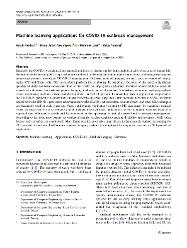| dc.contributor.author | Heidari, Arash | |
| dc.contributor.author | Navimipour, Nima Jafari | |
| dc.contributor.author | Unal, Mehmet | |
| dc.contributor.author | Toumaj, Shiva | |
| dc.date.accessioned | 2023-10-19T15:12:48Z | |
| dc.date.available | 2023-10-19T15:12:48Z | |
| dc.date.issued | 2022 | |
| dc.identifier.issn | 0941-0643 | |
| dc.identifier.issn | 1433-3058 | |
| dc.identifier.uri | https://doi.org/10.1007/s00521-022-07424-w | |
| dc.identifier.uri | https://hdl.handle.net/20.500.12469/5535 | |
| dc.description.abstract | Recently, the COVID-19 epidemic has resulted in millions of deaths and has impacted practically every area of human life. Several machine learning (ML) approaches are employed in the medical field in many applications, including detecting and monitoring patients, notably in COVID-19 management. Different medical imaging systems, such as computed tomography (CT) and X-ray, offer ML an excellent platform for combating the pandemic. Because of this need, a significant quantity of study has been carried out; thus, in this work, we employed a systematic literature review (SLR) to cover all aspects of outcomes from related papers. Imaging methods, survival analysis, forecasting, economic and geographical issues, monitoring methods, medication development, and hybrid apps are the seven key uses of applications employed in the COVID-19 pandemic. Conventional neural networks (CNNs), long short-term memory networks (LSTM), recurrent neural networks (RNNs), generative adversarial networks (GANs), autoencoders, random forest, and other ML techniques are frequently used in such scenarios. Next, cutting-edge applications related to ML techniques for pandemic medical issues are discussed. Various problems and challenges linked with ML applications for this pandemic were reviewed. It is expected that additional research will be conducted in the upcoming to limit the spread and catastrophe management. According to the data, most papers are evaluated mainly on characteristics such as flexibility and accuracy, while other factors such as safety are overlooked. Also, Keras was the most often used library in the research studied, accounting for 24.4 percent of the time. Furthermore, medical imaging systems are employed for diagnostic reasons in 20.4 percent of applications. | en_US |
| dc.language.iso | eng | en_US |
| dc.publisher | Springer London Ltd | en_US |
| dc.relation.ispartof | Neural Computing & Applications | en_US |
| dc.rights | info:eu-repo/semantics/openAccess | en_US |
| dc.subject | Deep | En_Us |
| dc.subject | Model | En_Us |
| dc.subject | Images | En_Us |
| dc.subject | Machine learning | en_US |
| dc.subject | Applications | en_US |
| dc.subject | COVID-19 | en_US |
| dc.subject | Medical imaging | en_US |
| dc.subject | Outbreak | en_US |
| dc.title | Machine learning applications for COVID-19 outbreak management | en_US |
| dc.type | review | en_US |
| dc.identifier.startpage | 15313 | en_US |
| dc.identifier.endpage | 15348 | en_US |
| dc.authorid | Jafari Navimipour, Nima/0000-0002-5514-5536 | |
| dc.authorid | Heidari, Arash/0000-0003-4279-8551 | |
| dc.authorid | Toumaj, Shiva/0000-0002-4828-9427 | |
| dc.identifier.issue | 18 | en_US |
| dc.identifier.volume | 34 | en_US |
| dc.department | N/A | en_US |
| dc.identifier.wos | WOS:000809323500001 | en_US |
| dc.identifier.doi | 10.1007/s00521-022-07424-w | en_US |
| dc.identifier.scopus | 2-s2.0-85131558400 | en_US |
| dc.institutionauthor | N/A | |
| dc.relation.publicationcategory | Diğer | en_US |
| dc.authorwosid | Jafari Navimipour, Nima/AAF-5662-2021 | |
| dc.authorwosid | Heidari, Arash/AAK-9761-2021 | |
| dc.identifier.pmid | 35702664 | en_US |
| dc.khas | 20231019-WoS | en_US |
















